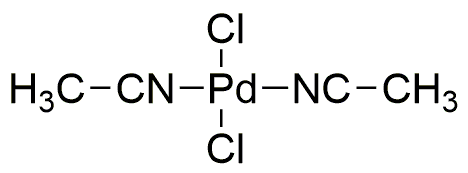Bis(acetonitrile)palladium(II) dichloride is widely utilized in research focused on:
- Catalysis: This compound is a key catalyst in various organic reactions, particularly in cross-coupling reactions like Suzuki and Heck reactions, which are essential in the synthesis of pharmaceuticals and agrochemicals.
- Electrochemistry: It serves as an effective precursor for palladium nanoparticles, which are used in electrochemical sensors and fuel cells, enhancing their efficiency and performance.
- Material Science: The compound is employed in the development of advanced materials, such as conductive polymers and nanocomposites, which find applications in electronics and energy storage devices.
- Organic Synthesis: Its ability to facilitate the formation of carbon-carbon bonds makes it invaluable in the synthesis of complex organic molecules, aiding researchers in drug discovery and development.
- Environmental Applications: It is also explored for its potential in catalytic converters and pollution control technologies, helping to reduce harmful emissions in industrial processes.
General Information
Properties
Safety and Regulations
Applications
Bis(acetonitrile)palladium(II) dichloride is widely utilized in research focused on:
- Catalysis: This compound is a key catalyst in various organic reactions, particularly in cross-coupling reactions like Suzuki and Heck reactions, which are essential in the synthesis of pharmaceuticals and agrochemicals.
- Electrochemistry: It serves as an effective precursor for palladium nanoparticles, which are used in electrochemical sensors and fuel cells, enhancing their efficiency and performance.
- Material Science: The compound is employed in the development of advanced materials, such as conductive polymers and nanocomposites, which find applications in electronics and energy storage devices.
- Organic Synthesis: Its ability to facilitate the formation of carbon-carbon bonds makes it invaluable in the synthesis of complex organic molecules, aiding researchers in drug discovery and development.
- Environmental Applications: It is also explored for its potential in catalytic converters and pollution control technologies, helping to reduce harmful emissions in industrial processes.
Documents
Safety Data Sheets (SDS)
The SDS provides comprehensive safety information on handling, storage, and disposal of the product.
Product Specification (PS)
The PS provides a comprehensive breakdown of the product’s properties, including chemical composition, physical state, purity, and storage requirements. It also details acceptable quality ranges and the product's intended applications.
Certificates of Analysis (COA)
Search for Certificates of Analysis (COA) by entering the products Lot Number. Lot and Batch Numbers can be found on a product’s label following the words ‘Lot’ or ‘Batch’.
Número de catálogo
Número de lote/lote
Certificates Of Origin (COO)
This COO confirms the country where the product was manufactured, and also details the materials and components used in it and whether it is derived from natural, synthetic, or other specific sources. This certificate may be required for customs, trade, and regulatory compliance.
Número de catálogo
Número de lote/lote
Safety Data Sheets (SDS)
The SDS provides comprehensive safety information on handling, storage, and disposal of the product.
DownloadProduct Specification (PS)
The PS provides a comprehensive breakdown of the product’s properties, including chemical composition, physical state, purity, and storage requirements. It also details acceptable quality ranges and the product's intended applications.
DownloadCertificates of Analysis (COA)
Search for Certificates of Analysis (COA) by entering the products Lot Number. Lot and Batch Numbers can be found on a product’s label following the words ‘Lot’ or ‘Batch’.
Número de catálogo
Número de lote/lote
Certificates Of Origin (COO)
This COO confirms the country where the product was manufactured, and also details the materials and components used in it and whether it is derived from natural, synthetic, or other specific sources. This certificate may be required for customs, trade, and regulatory compliance.

